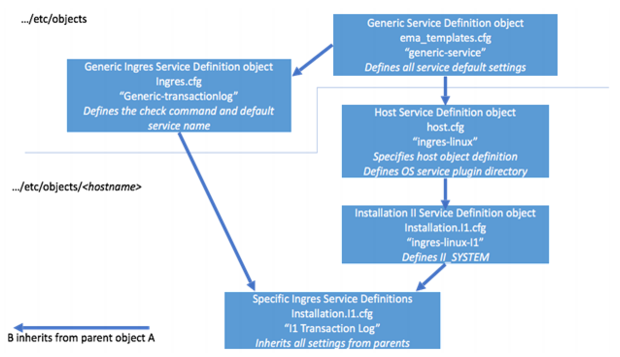.../nagios/etc/objects
This directory contains the “object” configuration files.
The documentation for the definitions in configuration files in the objects directory and files in the host subdirectories (see below) can be found at:
https://assets.nagios.com/downloads/nagioscore/docs/nagioscore/4/en/objectdefinitions.htmlThe EMA object hierarchy represents the types of objects you find in an Ingres installation. All the object definitions in the diagram below, except for the Specific Service Definitions, are template definitions that are not actually monitoring a service and only represent an object in the inheritance hierarchy. In a Nagios configuration file, these are defined using the “register 0” property.
The EMA configures the Nagios system to read every “.cfg” file in the etc/objects directory. Refer to the “Object Configuration Directory” setting in the main “nagios.cfg” file documentation.
The best approach to customizing a Nagios configuration is to use existing configuration files as an example.
The objects directory holds the system-wide configuration information. During setup the EMA install procedure uses template files to generate the custom configuration for the site. These files can be identified by the suffix “@@“.
The files in this directory that are most likely to be modified for site customization are:
• hostname.cfg
• contact.cfg
• contactgroups.cfg
• ema_timeperiods.cfg.
hostname.cfg
This file contains the basic name of the monitored host and the FQDN. These will be the same name as defined during the configuration process.
contact.cfg
This is a generated file from a template and contains a specific name and email address that typically is used for alarms and notifications. You can add additional contacts for email alerts and notifications to this file.
contactgroups.cfg
A contact group is simply a collection of contacts. EMA uses a specific contact group “ema-admins” as the default for all alerts and notifications. Any contact added to the “contact.cfg” file should be added to the “ema-admins” group as well.
ema_timeperiods.cfg
This file controls service check schedules. All service checks run every three minutes 24x7x365. Customizing this file is for advanced users; it can be necessary at sites with complex operations schedules.
databases.cfg
This file contains the generic service definitions for checks that can be specified by database. By default the EMA does not provide services checks by database. It monitors all databases equally.
ema_commands.cfg
This file defines every command that executes a plug-in. Service and host checks specify these command objects. There is not necessarily a one-to-one relationship between a service check and the command that check uses to monitor the remote service.
ema_contacts.cfg
This file contains the generic definition of contacts in the EMA. Defaults are provided for most Nagios contact configuration settings here.
ema_service_groups.cfg
There are several Nagios service groups defined by default by the EMA. They are a convenience only and show up on the Nagios web console.
ema_templates.cfg
This file defines most of the default behavior for various types of service checks on the EMA. More detailed descriptions of all the services options can be found at:
ingres.cfg
This file contains all Ingres service check generic object definitions. Each host installation service check will inherit the definitions found here.
os_templates.cfg
This file contains all the operating system service check generic object definitions. Each host specific service check will inherit the definitions found here.

